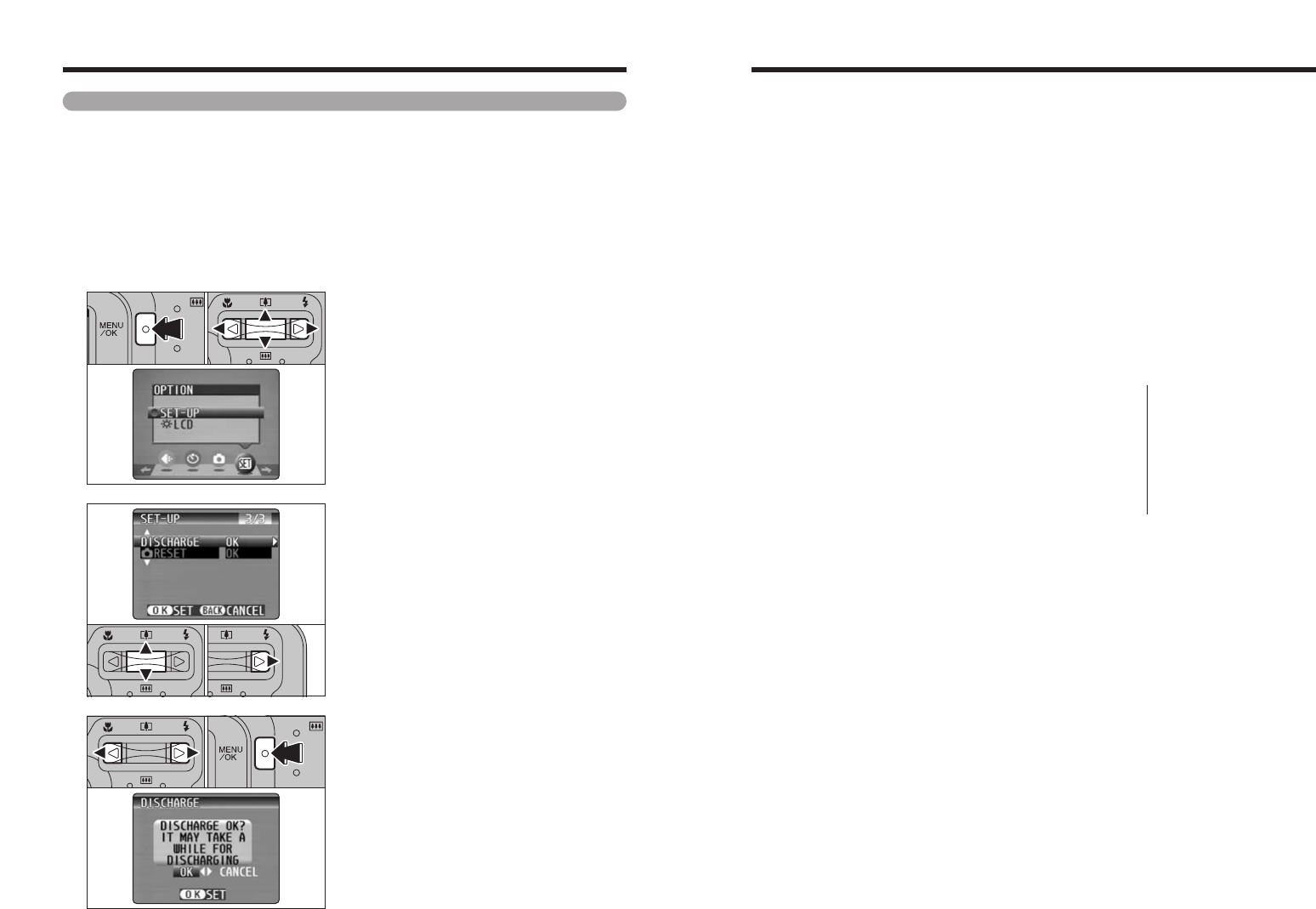
71
Notes on the xD-Picture Card™
■ Image Memory Card
hThis Image Memory Card is a new image recording
media (xD-Picture Card) developed for digital
cameras. The Image Memory Card consists of a
semiconductor memory (NAND-type flash memory)
to record digital image data.
The recording process is electrically performed and
enables erasure of existing image data as well as re-
recording of new image data.
hWhen using a new Memory Card, or a Memory Card
that has been initialized by a PC, be sure to initialize
(format/initialize) the card with your digital camera
before using it.
■ Protecting Your Data
hData may be lost or destroyed in the following
situations. Please note that FUJIFILM assumes no
responsibility for data that is lost or destroyed.
1. Removal of the memory card or turning the power
off while the memory card is being accessed (i.e.,
during record, erase, initialization, and playback
operations).
2. Improper handling and use of the memory card by
the user or third party.
hWe recommend saving your important data to
another media (i.e., MO disk, CD-R, hard disk, etc.).
■ Notes on Handling xD-Picture Card
hKeep xD-Picture Cards out of the reach of small
children. When storing xD-Picture Cards, ensure
that they are kept in a location out of the reach of
small children to prevent a card being accidentally
swallowed. An xD-Picture Card could cause
suffocation if accidentally swallowed. If a child
swallows an xD-Picture Card, seek medical advice
immediately.
hMake sure that the memory card is straight when
you insert into the camera etc.
hThe memory card is a precision electronic
instrument. Do not apply pressure or shock, and
avoid bending.
hDo not use the memory card in a hot, humid, or
corrosive environment.
hIf the contact area on the card is soiled (dust,
fingerprints, etc.), wipe it clean with a soft, dry cloth.
hClean the memory card with a soft dry piece of cloth
when dirty.
hxD-Picture Cards should be kept in their special
cases or carrying cases when being stored or
carried around.
hThe memory card can be used reliably for a long
period of time, but will eventually lose its ability to
store and play back image data. At this point,
replace with a new memory card.
hNever remove the xD-Picture Card or switch the
camera off during data recording, during data
erasing (xD-Picture Card formatting) or during
frame advance when images are being played back.
These actions could result in damage to the xD-
Picture Card.
hThe use of xD-Picture Cards is recommended with
the FinePix A205/FinePix A210.
The camera quality cannot be guaranteed when
cards other than those manufactured by FUJIFILM
are used.
hThe xD-Picture Card may feel warm when it is
removed from the camera after extended periods of
picture taking or image viewing. This is normal and
does not indicate a fault.
hDo not affix labels to the xD-Picture Card.
This could result in the label peeling off and causing
a fault when the card is inserted or removed.
■ Notes on Using xD-Picture Card with a
PC
hIf you intend to take photos using an xD-Picture
Card that has been used on a PC, format the xD-
Picture Card on your camera.
hWhen you format an xD-Picture Card in the camera
and then shoot and record images, a directory
(folder) is automatically created. Image data is then
recorded in this directory.
hDo not change or delete the directory (folder) names
or file names on the xD-Picture Card from your PC
as this will make it impossible to use the xD-Picture
Card in your camera.
hAlways use the camera to erase image data on an
xD-Picture Card.
hTo edit image data, copy the image data to the PC’s
hard disk and then edit the copied data.
hDo not copy files other than those that will be used
by the camera.
■ Specifications
Type Image memory card for digital
cameras (xD-Picture Card)
Memory type NAND-type flash memory
Conditions for use Temperature:
0°C to +40°C
(+32°F to +104°F)
Humidity:
80% max. (no condensation)
Dimensions 25 mm × 20 mm × 2.2 mm
(0.98 in. × 0.79 in. × 0.09 in.)
(W × H × D)
70
1Press “a” or “b” to select “DISCHARGE”.
2Press “c”.
2
01 02
Procedure for discharging rechargeable Ni-MH batteries
Only use the “Discharging rechargeable batteries” function with Ni-MH batteries
(rechargeable batteries).
The “Discharging rechargeable batteries” function should not be used with
alkaline batteries as it will completely drain the battery charge.
Use the “Discharging rechargeable batteries” function in the following situations:
i When the batteries can only be used for a short time after being charged normally
i When the batteries have not been used for a long period
i When you purchase new Ni-MH batteries
Do not use the “Discharging rechargeable batteries” function when the camera is set in the cradle or
when you are using the AC power adapter. In these situations, the Ni-MH batteries will not be
discharged due to the external power supply.
1
1Press the “MENU/OK” button.
2Press “d” or “c” to select “F” OPTION and
then press “a” or “b” to select “SET-UP”.
3Press the “MENU/OK” button.
01 03 02
●
!
Remove the camera from the cradle when discharging
batteries.
●
!
Do not use the procedure for discharging
rechargeable batteries with alkaline batteries.
1Press “d” or “c” to select “OK”.
2Press the “MENU/OK” button.
The screen changes and discharging begins.
When the red battery low indicator starts
blinking and discharging ends, the camera
switches off.
3
01
02
●
!
To cancel discharging, press the “BACK” button.
Notes on the Power Supply


















